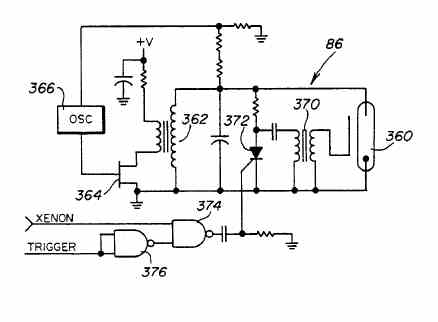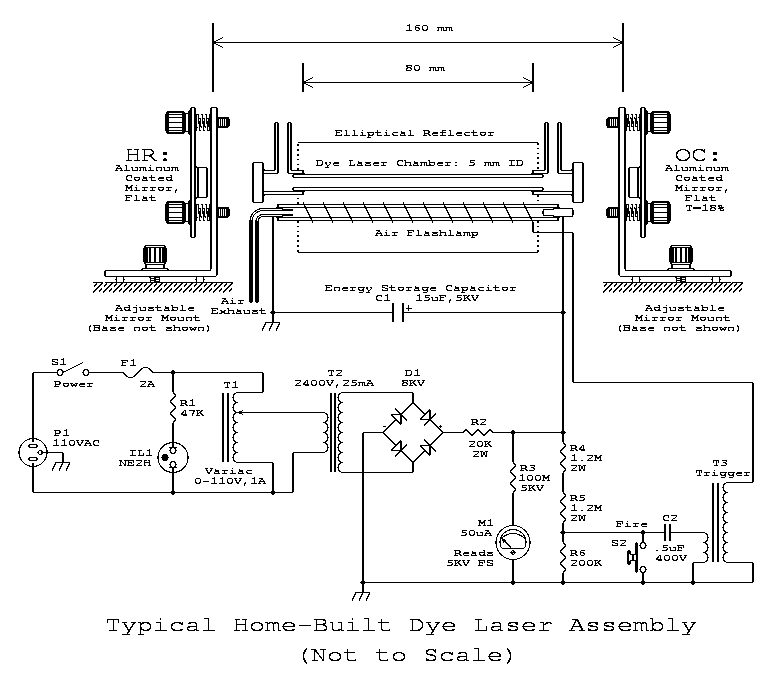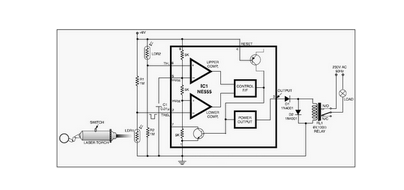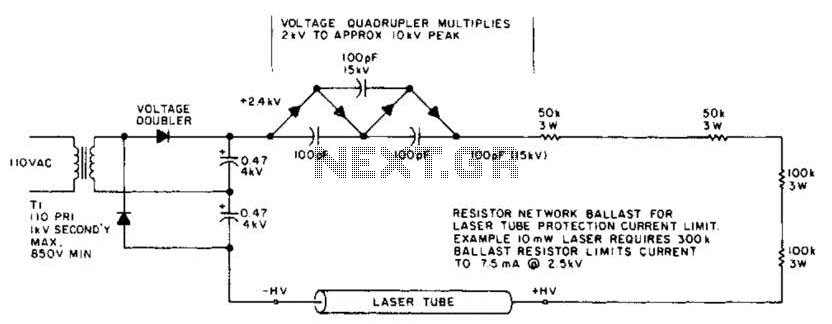
Home-Built Carbon Dioxide (CO2) Laser
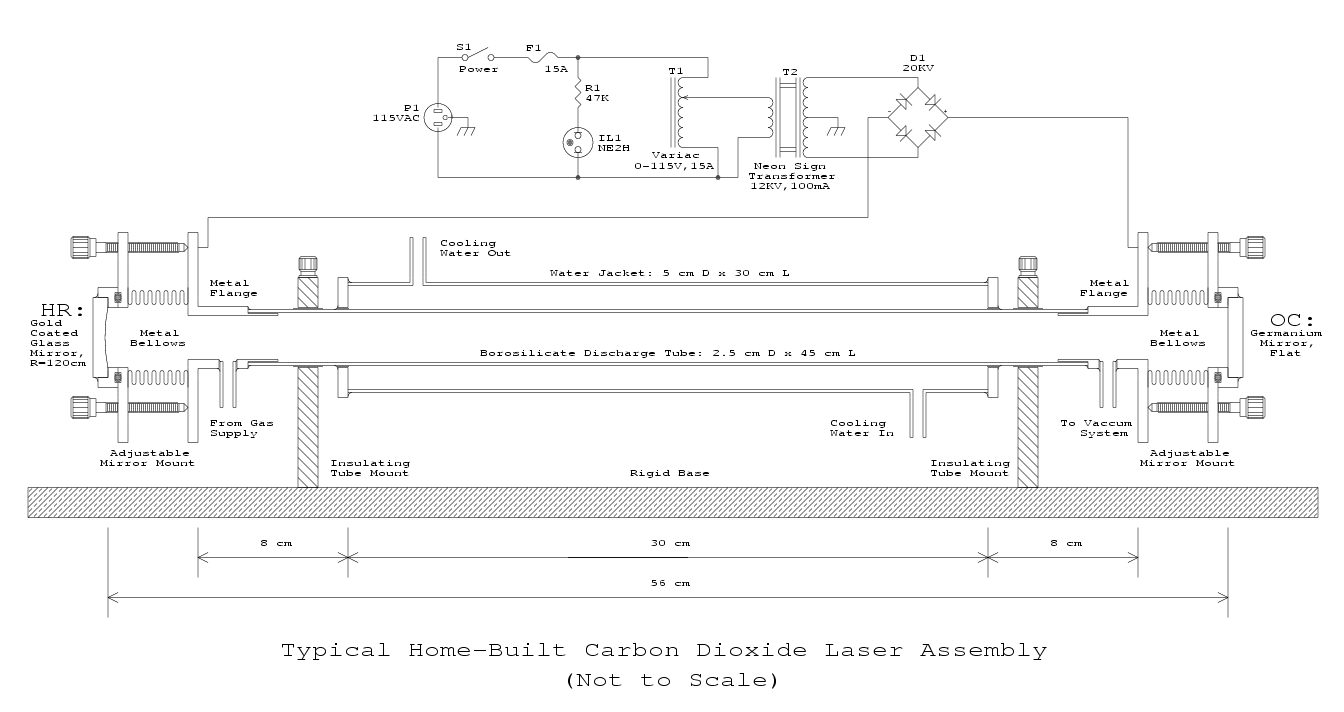
The carbon dioxide (CO2) laser serves as a critical tool in high-tech industrial applications such as cutting and welding various materials, including metals. Smaller CO2 lasers are utilized for marking metals, wood, and composites, as well as in medical and surgical procedures. Even compact CO2 lasers generate tens of watts of beam power, while larger models can reach up to 100 kW. The laser emits light at a wavelength of approximately 10,600 nm in the mid-infrared range, which is significantly longer than that of many other lasers. This characteristic makes it more of a heat source than a light source. At this wavelength, conventional glass and plastic optics are often unsuitable due to high losses or opacity, necessitating the use of alternative materials for mirrors, lenses, and prisms in the optical system. The increased divergence and diffraction effects at this wavelength also pose challenges in achieving a collimated beam. However, many materials, such as wood, paper, plastics, composites, and suitably prepared metal surfaces, absorb this wavelength effectively, making CO2 lasers suitable for marking, cutting, welding, and heat treatment applications.
It is feasible for an amateur to construct a functioning axial flow CO2 laser (non-sealed) in the 10 to 50 W range with relative ease compared to other laser types. A vacuum system is required, but the operational vacuum range is manageable, between 10 to 100 Torr. The gas purity required is less stringent than for other lasers like HeNe, and pre-mixed gases are readily available. With resourcefulness, complex glasswork can be avoided. A neon sign transformer controlled by a Variac can serve as the power supply. The mechanical precision required is also less demanding, allowing for the fabrication of adequate mirror mounts and structural components even with limited machining skills. Unlike traditional gas lasers, CO2 lasers need minimal maintenance once constructed and aligned, provided they are properly packaged with essential safety features. Some commercial axial flow CO2 lasers are advanced versions of what an amateur can create.
The CO2 laser beam is invisible, which can be less stimulating for some users. Despite this, it remains an excellent choice for home-built laser projects due to its high power, continuous operation, and relative simplicity. However, it should be noted that while constructing a CO2 laser is easier than building other types, it still requires a significant commitment of time and effort. Challenges are likely to arise, and costs can escalate if one does not possess the necessary supporting equipment, such as a vacuum pump or power supply components. For those seeking a reliable laser without the complexities of construction, purchasing a used CO2 laser system may be a more economical option. Sealed tube CO2 laser systems, which require no gas supply or vacuum system, offer virtually zero maintenance and are worth considering for those with a higher budget.
The CO2 laser operates on the principle of stimulating a gas mixture, typically composed of carbon dioxide, nitrogen, and helium, to produce a coherent beam of light. The laser cavity consists of mirrors that reflect the light back and forth, amplifying it until it emerges as a high-power beam. The optical setup must be carefully designed to accommodate the specific wavelength and ensure effective focusing and collimation of the beam. Proper alignment of the mirrors and components is crucial for maximizing efficiency and output power.
Safety considerations are paramount when working with CO2 lasers, as the invisible beam can cause serious injury. Protective eyewear specifically designed for the mid-infrared spectrum should be worn at all times. Additionally, the workspace should be equipped with safety interlocks and protective barriers to prevent accidental exposure to the laser beam. Proper ventilation is also necessary to mitigate the risks associated with the byproducts of laser cutting and engraving processes.
In summary, the CO2 laser is a versatile tool that offers significant advantages for industrial and amateur applications alike. Its capability to efficiently cut, weld, and mark a variety of materials makes it an invaluable asset in many fields, provided that safety and operational considerations are adequately addressed.The carbon dioxide (CO2) laser is the powerhouse for high tech industrial cutting and welding of metals and many other materials. Small CO2 lasers are used for marking of metal, wood, and composites, and in medicine and surgery. Even a `small` CO2 laser produces 10s of watts of beam power and the largest are in the 100 kW range!
Its output is at 1 0. 6 um (10, 600 nm) or mid-IR. This wavelength is about 10 to 30 times longer than the other lasers under discussion and often considered a source of a heat beam than a light beam. At this wavelength, normal glass and plastic optics are either too lossy or totally opaque so alternatives must be found both for the end-mirrors and any other mirrors, lenses, or prisms required by the external optical setup.
Divergence/diffraction effects are also increased by this same factor so obtaining a collimated beam is also more difficult. Many common materials including wood, paper, plastics, composites, and properly prepared metal surfaces absorb quite well at this wavelength so the CO2 laser makes an effective marking, cutting, welding, and heat treating tool.
It is possible for an amateur to construct a working axial flow CO2 laser (non-sealed, see the chapter: Carbon Dioxide Lasers ) in the 10 to 50 W range without too much difficulty - at least compared to some of the other types of lasers described in this chapter. A vacuum system is needed but the range of operating vacuum is modest - 10 to 100 Torr. And while several gases are needed, the purity of the final gas fill isn`t nearly as critical as for, say, the HeNe laser, and pre-mixed gas is readily available.
See the section: More on Obtaining Gases. With a bit of resourcefulness, no fancy glass work is needed. The power supply can be just a neon sign transformer on a Variac. The required mechanical precision isn`t as great either so even if your machining skills are quite limited, adequate mirror mounts and structural components can be fabricated relatively easily. And, unlike the other traditional gas lasers (HeNe, Ar/Kr ion, HeHg, CuCl/CuBr, and the like), once constructed and aligned, the CO2 laser requires minimal maintenance and can potentially be a useful tool for real applications IFF it is packaged appropriately and provided with essential safety interlocks and protection devices.
In fact, some commercial axial flow CO2 lasers are just refined versions of what an amateur can build. See the section: Descriptions of Typical Small Flowing Gas CO2 Lasers. My only complaint about CO2 lasers in general are that the beam is totally invisible and boring in some ways.
:-) Otherwise, it is nearly the perfect choice for a home-built laser - high power, continuous operation, and relative simplicity! The following comments should be taken in a positive way in an attempt to head off a disappointing experience for someone who really hasn`t caught the amateur laser construction bug.
Although, constructing a CO2 laser is easy relative to other types of lasers, it is still NOT easy in an absolute sense. You will have to make a very considerable commitment of time and effort including dealing with the frustrations when, as is inevitable, some things don`t quite go according to the script!
The costs in $$$ can quickly become significant as well if you don`t already have any of the supporting equipment (e. g. , vacuum pump, power supply components) and aren`t a first rate scrounger. :) If all you want is a reliable working laser, save your money and buy a used CO2 laser system. Something similar to what you will be building can probably be acquired for under $1, 000, perhaps less depending on your resourcefulness and luck.
For example, see the section: How to Get a Laser Without Really Trying - Part 1. If you can afford a bit more, try to find a sealed tube CO2 laser system. These have essentially zero maintenance, and no requirements for a gas supply or vacuum system. New systems in 🔗 External reference
It is feasible for an amateur to construct a functioning axial flow CO2 laser (non-sealed) in the 10 to 50 W range with relative ease compared to other laser types. A vacuum system is required, but the operational vacuum range is manageable, between 10 to 100 Torr. The gas purity required is less stringent than for other lasers like HeNe, and pre-mixed gases are readily available. With resourcefulness, complex glasswork can be avoided. A neon sign transformer controlled by a Variac can serve as the power supply. The mechanical precision required is also less demanding, allowing for the fabrication of adequate mirror mounts and structural components even with limited machining skills. Unlike traditional gas lasers, CO2 lasers need minimal maintenance once constructed and aligned, provided they are properly packaged with essential safety features. Some commercial axial flow CO2 lasers are advanced versions of what an amateur can create.
The CO2 laser beam is invisible, which can be less stimulating for some users. Despite this, it remains an excellent choice for home-built laser projects due to its high power, continuous operation, and relative simplicity. However, it should be noted that while constructing a CO2 laser is easier than building other types, it still requires a significant commitment of time and effort. Challenges are likely to arise, and costs can escalate if one does not possess the necessary supporting equipment, such as a vacuum pump or power supply components. For those seeking a reliable laser without the complexities of construction, purchasing a used CO2 laser system may be a more economical option. Sealed tube CO2 laser systems, which require no gas supply or vacuum system, offer virtually zero maintenance and are worth considering for those with a higher budget.
The CO2 laser operates on the principle of stimulating a gas mixture, typically composed of carbon dioxide, nitrogen, and helium, to produce a coherent beam of light. The laser cavity consists of mirrors that reflect the light back and forth, amplifying it until it emerges as a high-power beam. The optical setup must be carefully designed to accommodate the specific wavelength and ensure effective focusing and collimation of the beam. Proper alignment of the mirrors and components is crucial for maximizing efficiency and output power.
Safety considerations are paramount when working with CO2 lasers, as the invisible beam can cause serious injury. Protective eyewear specifically designed for the mid-infrared spectrum should be worn at all times. Additionally, the workspace should be equipped with safety interlocks and protective barriers to prevent accidental exposure to the laser beam. Proper ventilation is also necessary to mitigate the risks associated with the byproducts of laser cutting and engraving processes.
In summary, the CO2 laser is a versatile tool that offers significant advantages for industrial and amateur applications alike. Its capability to efficiently cut, weld, and mark a variety of materials makes it an invaluable asset in many fields, provided that safety and operational considerations are adequately addressed.The carbon dioxide (CO2) laser is the powerhouse for high tech industrial cutting and welding of metals and many other materials. Small CO2 lasers are used for marking of metal, wood, and composites, and in medicine and surgery. Even a `small` CO2 laser produces 10s of watts of beam power and the largest are in the 100 kW range!
Its output is at 1 0. 6 um (10, 600 nm) or mid-IR. This wavelength is about 10 to 30 times longer than the other lasers under discussion and often considered a source of a heat beam than a light beam. At this wavelength, normal glass and plastic optics are either too lossy or totally opaque so alternatives must be found both for the end-mirrors and any other mirrors, lenses, or prisms required by the external optical setup.
Divergence/diffraction effects are also increased by this same factor so obtaining a collimated beam is also more difficult. Many common materials including wood, paper, plastics, composites, and properly prepared metal surfaces absorb quite well at this wavelength so the CO2 laser makes an effective marking, cutting, welding, and heat treating tool.
It is possible for an amateur to construct a working axial flow CO2 laser (non-sealed, see the chapter: Carbon Dioxide Lasers ) in the 10 to 50 W range without too much difficulty - at least compared to some of the other types of lasers described in this chapter. A vacuum system is needed but the range of operating vacuum is modest - 10 to 100 Torr. And while several gases are needed, the purity of the final gas fill isn`t nearly as critical as for, say, the HeNe laser, and pre-mixed gas is readily available.
See the section: More on Obtaining Gases. With a bit of resourcefulness, no fancy glass work is needed. The power supply can be just a neon sign transformer on a Variac. The required mechanical precision isn`t as great either so even if your machining skills are quite limited, adequate mirror mounts and structural components can be fabricated relatively easily. And, unlike the other traditional gas lasers (HeNe, Ar/Kr ion, HeHg, CuCl/CuBr, and the like), once constructed and aligned, the CO2 laser requires minimal maintenance and can potentially be a useful tool for real applications IFF it is packaged appropriately and provided with essential safety interlocks and protection devices.
In fact, some commercial axial flow CO2 lasers are just refined versions of what an amateur can build. See the section: Descriptions of Typical Small Flowing Gas CO2 Lasers. My only complaint about CO2 lasers in general are that the beam is totally invisible and boring in some ways.
:-) Otherwise, it is nearly the perfect choice for a home-built laser - high power, continuous operation, and relative simplicity! The following comments should be taken in a positive way in an attempt to head off a disappointing experience for someone who really hasn`t caught the amateur laser construction bug.
Although, constructing a CO2 laser is easy relative to other types of lasers, it is still NOT easy in an absolute sense. You will have to make a very considerable commitment of time and effort including dealing with the frustrations when, as is inevitable, some things don`t quite go according to the script!
The costs in $$$ can quickly become significant as well if you don`t already have any of the supporting equipment (e. g. , vacuum pump, power supply components) and aren`t a first rate scrounger. :) If all you want is a reliable working laser, save your money and buy a used CO2 laser system. Something similar to what you will be building can probably be acquired for under $1, 000, perhaps less depending on your resourcefulness and luck.
For example, see the section: How to Get a Laser Without Really Trying - Part 1. If you can afford a bit more, try to find a sealed tube CO2 laser system. These have essentially zero maintenance, and no requirements for a gas supply or vacuum system. New systems in 🔗 External reference
